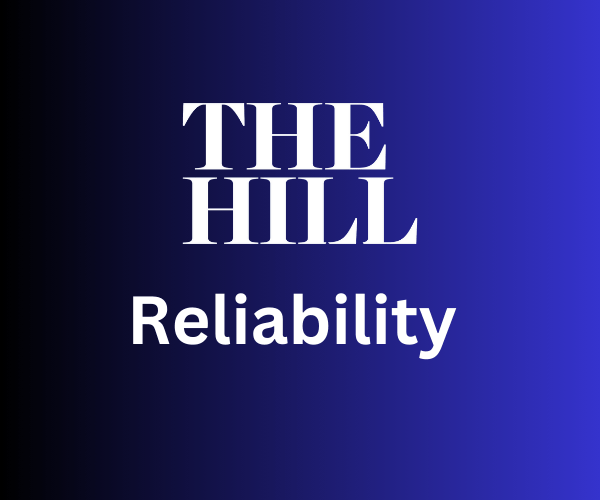
The Hill is a non-partisan newspaper and online source for and about American politics– specifically Congress, the White House, Capitol Hill, and so on. Founded in 1944 and based in Washington D.C., The Hill provides an up-close look surrounding all things American politics. Described as a “top US political website” (The Hill), this article will examine and analyze the reliability of this news source.
Biasly investigates and evaluates news sources based on their accuracy and dependability. Let us investigate whether or not The Hill is a trustworthy source for American politics.
Does Reliability Matter?
Reliability, in general, refers to how trustworthy or accurate information, or in this case, a news source is. If we consider this definition, it quickly becomes clear why reliability is important in media sources. If we can’t trust the things we read then there isn’t much of a point in continuing to consume content from that source, after all. So how exactly can we gauge the reliability of a news source anyways?
There are several potential measures of reliability to look out for when trying to determine whether a media source is reliable or not. Red flags for an unreliable article can include the presence of wild unsubstantiated claims, facts dependent on other unreliable sources, heavy use of opinionated language, and more. Some indicators of a reliable news source, on the other hand, include things like:
- Absence of subjective/opinionated language in articles
- Credible sources cited (e.g., neutral sources, .gov, .edu websites)
- Facts and statistics backed by multiple relevant outside sources
- Use of primary sources when possible (e.g., interviews, quotes)
- Information that remains consistent across news sources
So How Does The Hill Fare in its Reliability?
Biasly has developed a political bias index to objectively assess the dependability of news organizations. Biasly’s reliability rating for The Hill has an Analyst rating of Good reliability on our meter, which suggests that readers can trust a good amount of The Hill’s content online, and a Computer reliability rating of Fair on its source and quote quality. However, keep in mind that this is an average, indicating that certain articles are more or less trustworthy than others. Our findings are also aligned with those of other third-party searches showing mostly factual.
By analyzing the supporting data for these rankings, we will be able to determine the trustworthiness of this source, in addition to looking at the factors that impact the reliability of news articles.
The Hill Accuracy and Reliability
The credibility of a news organization is typically impacted by bias and political orientation. Just as every media organization has a political orientation to some extent, The Hill has historically leaned slightly right and then left at different times. As of now, it is Center-Right according to Biasly’s most recent Computer Analysis. We can evaluate the integrity of The Hill’s news stories and determine just how well claims are supported by evidence. Additionally, we will look at selection and omission bias in order to assess the organization’s correctness and factuality.
Selection bias is when stories and facts are selected or deselected, often on ideological grounds, to create a narrative in support of the new sources’ ideology. Omission bias, on the other hand, is when different opinions and political views regarding a situation are left out so that the reader is only exposed to the ideological perspective supported by the author. It’s important to keep in mind these two types of biases when trying to assess an article’s level of accuracy.
Biasly assigns a percentage score towards accuracy, ranging from one being the least accurate and 100 being the most. These ratings are calculated by weighing assertions with supporting evidence and number of reliable internal and external sources used in the articles. A full page of BIalsy’s dependability and reliability ratings for The Hill’s articles can be found here. The previous article on The Hill examined the political bias present in articles, which was determined overall to be Center-Right, with some articles leaning slightly left. Although this score varied from article to article, the most extreme variances in dependability are caused by bias; specifically selection and omission bias. Consider 90min, another Central source rated at 2% by Biasly, where they had one article that was determined to have a “Center” rating titled “Luis Diaz makes first public statement since the kidnapping of parents” and another article deemed “Somewhat Conservative” titled “Al Ittihad refuse to play AFC Champions League game in Iran over pitch-side statue.” This demonstrates that articles displaying political leaning are more likely to be biased and therefore less reliable than neutral ones.
Consider this article from The Hill titled “Americans’ confidence in science split heavily along party lines: Gallup” which is rated with an Excellent reliability rating from Biasly as well as rated Center-Left. Concerning selection and omission bias, author Rachel Scully does a good job in confiding in the Gallup poll, stating holistically that “Overall, 64 percent of Americans said they have confidence in science.” Beyond this, Gallup states that:
“The lack of confidence among Republicans may stem from conservative leaders’ allegations of liberal bias in the scientific community. It also tied the mistrust to issues surrounding COVID-19 vaccinations.”
As such, the article contains a slight liberal stance, portraying Republicans as distrustful of science– although the survey does denounce the results:
“The survey found that Democrats were very confident in science, with 79 percent saying they have ‘a great deal’ or ‘quite a lot’ of confidence in the field, compared to just 45 percent of Republicans, who said the same.”
Had the author pulled sources from both a liberal and conservative politician to gain their perspective on the statistics, the article could have avoided a slight liberal bias, particularly in the areas of selection and omission bias. However, the article can be considered mostly reliable due to its cited statistics.
We will take a closer look at more examples like this below, providing a further investigation into the reliability of The Hill’s articles, including the use of selection and omission bias and the quality of sources and facts used.
Analysis of Reliability in Hill Opinion Pieces
Opinion in journalism allows reporters to express their opinions and beliefs on certain topics. However, excessive opinion is something to avoid while producing a news article, as it will appear less trustworthy due to its subjectivity. With that being said, opinion pieces are still worthwhile to read to broaden one’s perspective and viewpoints.
The Hill produces opinion pieces on a wide variety of topics, including campaigning, international, technology, healthcare, and more.
Quality of Sources and Facts Used
The Hill produces opinion pieces from both sides of the ideological divide. Consider, for example, this opinion article titled “Immigration lessons from abroad– the US isn’t the only tightening its borders.” In this article from Tara D. Sonenshine, the author does not use any direct quotes but rather summarizes a plethora of information from a wide scale of news articles from around the world.
The author’s 11 sources for the article are as follows:
- AP News (Center-Left Leaning)
- Germany’s chancellor Olaf Scholz | Liberal, Social Democratic Party of Germany
- Deutsche Welle article– “German immigration policy: What’s changing in 2024?” (Center)
- com (Center Leaning)
- The New York Times (Very Liberal Leaning)
- BBC News (Center Leaning)
- UK Prime Minister Rishi Sunak (Conservative, Conservative Party of the UK)
- NPR (Somewhat Liberal Leaning)
- NBC News (Moderately Liberal Leaning)
- The European Conservative (Center)
- US Department of State- Office of the Historian: The Immigration Act of 1924 (The Johnson-Reed Act)
The number of sources used is a large, healthy number; however, most of the sources are liberal or center, causing the diversity score of the sources to be low. A low diversity score can impact the article’s trustworthiness and mean there is possible selection and omission bias present. To get a holistic view of the issue, the article would need to include more Conservative sources to balance this out. They also rely on the opinions, actions and systems proposed by countries such as Germany, France, and the UK and their respective political ideological stances. The sources include statistics or planned approaches to tackling immigration, including the following from Germany’s chancellor Olaf Scholz:
“Take Germany, for example. Olaf Scholz, announced at the end of the year that his country needed a new system for dealing with people who do not meet asylum criteria. In an interview with the news magazine Der Spiegel, he came out in support of large-scale deportations for rejected asylum applicants.”
“In the first half of 2023, government data show that close to 8,000 people were deported from Germany. The new ‘Repatriation Improvement Act’ seeks to increase that figure and end the announcement of deportations in advance.”
In continuance, the diversity of sources gathered highlights that the author uses mostly Liberal sources, While you could argue that the author uses predominantly liberal sources, there are still Conservative sources included in the article, such as the UK Prime Minister, who is the leader of the Conservative Party in the UK, You could argue that the opinion piece is tailored for liberals, therefore the use of majority liberal sources is not a surprise; especially considering Biasly’s Analyst ratings for the source to be Moderately/Somewhat Liberal.
Selection and Omission Bias
Another example from The Hill titled “For the Biden administration’s 2024 regulations, timing is crucial” explores the goals and objectives of the Biden administration for the new year. The article acknowledges in its opening sentence that Congress is unlikely to pass any major legislation in 2024 and that most policymaking will take place in the executive branch, a call to action towards the Biden administration.
Author Stuart Shapiro remains objective in assessing the goals of the administration, stating:
“Since President Biden is neither a lame duck nor an incumbent facing a comfortable reelection, his administration has to balance these competing concerns in thinking about the timing of finalizing regulations. If the administration issues them too soon, an opponent who is likely to make regulation a central campaign issue will decry government overreach. Issue them too late and lose the election, and your opponent could happily sign congressional resolutions overturning your key initiatives.”
There is no emotionally loaded language towards any political party or politician, regardless of the author’s personal political ideologies. The author simply acknowledges that regulatory processes and regulations are at the forefront of the Administration’s concerns for the year and that Biden’s campaign strategy will be impacted by how they release those.
The author does not appear to select or deselect political facts to create a narrative in support of The Hill’s ideology. Rather, Shapiro writes an informative piece on the critical goals and objectives of the Biden administration in 2024. Similarly, there is little omission bias present that would expose an audience to a certain political perspective supported by the author.
So, while opinion pieces can have issues with factuality, sourcing, selection, and omission bias, the articles covered by The Hill remain informative, and properly sourced and limit political biases. As a news organization with a central political ideology, The Hill does have a small incentive to continue appealing to both liberal, conservative, and independent viewpoints to maintain their company’s interests. Now that we’ve enumerated several indications of reliability in a news article, you can use these same factors to stay informed on the most accurate news.
So Is The Hill Reliable?
In conclusion, it can be argued that The Hill is mostly a reliable news source with an adequate reputation for integrity and accuracy. The more you research media reliability and accuracy, the easier it will be for you to spot problems with sources, selection, omission, and factuality. Biasly’s News Bias Checker uncovers reliability problems and assists you in finding the most accurate and dependable news.


























